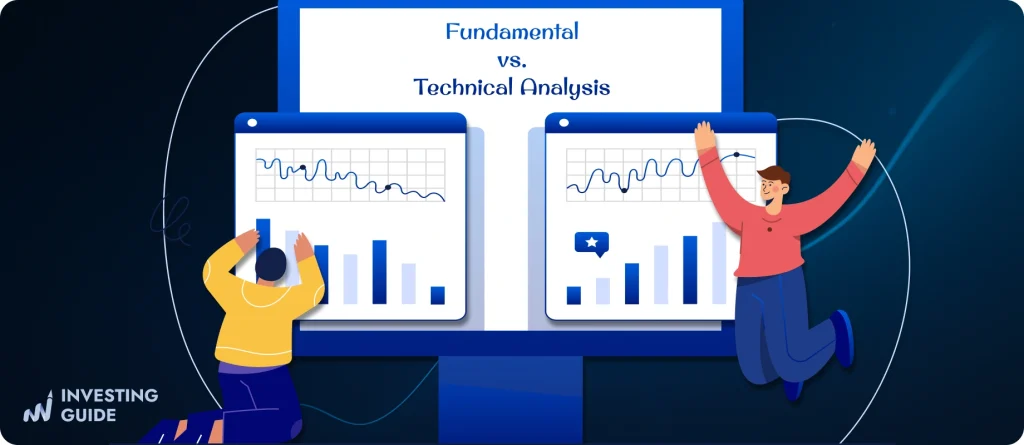Yulia Pavliuk is a financial content writer with a background in language, education, and clear communication. She creates SEO-friendly articles that make complex finance topics like ETFs and forex signals clear and accessible, with a strong focus on UK audiences.
We may receive compensation from our partners for placement of their products or services, which helps to maintain our site. We may also receive compensation if you click on certain links posted on our site. While compensation arrangements may affect the order, position or placement of product information, it doesn’t influence our assessment of those products.
The stock market can be disorienting.. Prices shift, headlines compete, and trends appear and vanish. For UK investors, fundamental analysis provides a vital foundation for informed decisions amid uncertainty.
Rather than reacting to speculation or short-term sentiment, this approach focuses on assessing the underlying financial and strategic health of a business. It encourages investors to look beyond share price movements and examine whether a company’s valuation is supported by its actual performance, structure, and prospects.
In this guide, we explore how fundamental analysis works, why it remains a cornerstone of long-term investing, and how it can help you approach the markets with greater clarity, discipline, and confidence.
What Is Fundamental Analysis?

At its core, fundamental analysis is the practice of evaluating a company’s financial and economic foundations to determine whether its current share price reflects its true value.
Rather than relying on charts or price patterns (as with technical analysis), fundamental analysis asks deeper questions:
- How much profit is the company generating?
- What are its growth prospects over the next few years?
- Is its debt manageable?
- Does it have a competitive advantage?
This method is widely used by long-term investors — from seasoned fund managers to private individuals managing their portfolios — who want to invest in businesses, not just tickers.
Think of it as buying a house. You wouldn’t just look at the front door and ask how much it costs today. You’d want to inspect the structure, the neighbourhood, and the long-term value. The same principle applies here.
The Two Main Types of Fundamental Analysis
Fundamental analysis has two key dimensions: qualitative and quantitative. Each offers a different angle on a company’s value — one focused on business quality, the other on financial strength.
Qualitative Analysis: Understanding the Business
This side looks beyond numbers to assess a company’s core attributes:
- Business model – How does it generate revenue? Is it scalable or capital-intensive?
- Management – Does the leadership have a solid track record and sound judgment?
- Competitive edge – Does the company have brand strength or market dominance?
- Sector trends – Is it operating in a growing or declining industry?
These factors help gauge long-term potential. They’re not easily measured, but they shape everything else.
Quantitative Analysis: Measuring Performance
This is where the data lives — drawn from the company’s financial statements:
- Revenue – Total income from operations. Growth matters, but so do margins.
- EPS (Earnings per Share) – Shows profit per share, reflecting shareholder value.
- P/E Ratio – Tells you how much investors pay per £1 of earnings.
- Debt-to-Equity – Indicates financial risk and borrowing dependence.
- ROE (Return on Equity) – Measures how efficiently the company uses shareholder funds.
Together, these metrics reveal profitability, risk, and value, but they make sense only when considered in the context of the broader business story.
Used together, qualitative and quantitative analysis provide a clear, well-rounded view of what you’re investing in — and why it may (or may not) be worth it.
Why Fundamental Analysis Matters in the UK Market

British investors face unique challenges: a mix of legacy FTSE giants, emerging tech startups, and global firms listed in London but based abroad. Navigating this landscape requires more than a casual glance at share prices.
Fundamental analysis helps:
- Avoid overpriced hype stocks often fuelled by short-term sentiment.
- Identify undervalued companies with solid long-term potential.
- Understand how broader economic changes (like interest rate hikes or inflation) affect specific sectors.
For instance, if a UK-listed retailer reports steady earnings growth despite inflationary pressures, that resilience could signal strong management and pricing power — two qualities that may indicate a solid investment, regardless of market noise.
How to Conduct Effective Fundamental Analysis
Fundamental analysis is most effective when approached with structure and clarity. Below is a five-step framework used by many successful investors to evaluate whether a company is fundamentally sound and worth further consideration.
1. Understand the Business
Begin with a clear grasp of the company’s operations. What products or services does it offer? Who are its core customers? Is the business model scalable and sustainable? A company’s long-term viability often depends as much on strategy and relevance as on short-term financials.
If its operations or revenue streams are unclear, that’s a red flag. Investing should begin with businesses you can logically explain and believe in.
2. Analyse the Financial Statements
Once the business model is clear, turn to the numbers. Focus on three key documents:
- Income statement – reveals profitability over a defined period.
- Balance sheet – outlines assets, liabilities, and shareholder equity.
- Cash flow statement – shows how cash is generated and used, clarifying the strength behind reported earnings.
These reports are typically available through the company’s investor relations section or on trusted financial data platforms, such as the London Stock Exchange, FT.com, or Yahoo Finance UK.
3. Examine Core Financial Ratios
Ratios translate raw data into insight. A few of the most informative include:
- Price-to-Earnings (P/E) Ratio – Indicates how the market values the company relative to its earnings.
- Debt-to-Equity Ratio – Gauges financial leverage and exposure to interest rate risk.
- Profit Margin – Measures efficiency in converting revenue into profit.
Interpret these figures in context. A seemingly high or low ratio only becomes meaningful when compared to historical performance, sector averages, or direct competitors.
4. Evaluate Growth and Stability
Consistency is often more telling than one-off results. Look for trends over multiple periods:
- Is revenue growing at a sustainable rate?
- Are profits stable, or marked by volatility?
- Do cash flows support earnings, or are results flattered by accounting choices?
Businesses that show steady, reliable growth tend to offer more predictable long-term value.
5. Consider the Broader Environment
Even a well-run company can be affected by macroeconomic or sector-specific headwinds. Consider factors such as:
- Regulatory pressure or legislative risk within its industry
- Competitive threats or technological disruption
- Broader economic indicators — inflation, interest rates, and consumer sentiment in the UK market
Good analysis doesn’t end with the company. It includes understanding the environment in which that company operates — and whether it’s positioned to adapt and thrive.
Common Pitfalls to Avoid
Fundamental analysis is powerful, but not foolproof. A few traps to watch out for:
- Confirmation bias – Looking for evidence to back what you already believe.
- Outdated data – Financial reports are usually quarterly, but market events move faster.
- Ignoring intangibles – Culture, customer loyalty, and innovation don’t always show up in the numbers.
Always aim for a balanced view — numbers matter, but so does the story behind them.
Fundamental vs. Technical Analysis

It’s easy to think of fundamental and technical analysis as rival schools of thought — one focusing on facts and figures, the other on charts and timing. But in practice, these two methods aren’t enemies. They answer different questions, and when used together, they can help investors make more informed decisions.
Fundamental analysis looks at a company’s value, including its profits, strategy, sector position, and long-term outlook. It helps investors decide what to invest in, based on real business performance, not market noise.
Technical analysis focuses on price behaviour: trends, momentum, and trading volumes. It helps decide when to invest, spotting short-term entry or exit points.
For UK investors building long-term portfolios, such as ISAs or pensions, fundamental analysis should be the primary approach. It shows whether a company is worth owning. Technical analysis can complement it by helping identify more favourable moments to buy or sell.
Together, they form a fuller picture: one based on both substance and timing.
When Fundamental Analysis Works Best
Not all investment strategies require in-depth company analysis. But fundamental analysis shines in:
- Building a long-term portfolio (e.g. retirement planning, ISA investing)
- Dividend investing – where consistent cash flow is crucial
- Value investing – spotting underpriced companies with strong fundamentals
It’s less useful if you’re day-trading or speculating on quick market moves — in those cases, price momentum may matter more than balance sheets.
FAQs
Yes — many UK investors start with basic ratio checks and reading annual reports. You don’t need to be a CFA to understand whether a business is profitable or drowning in debt.
Every quarter is a good rhythm, as most companies report earnings quarterly. Major news (like a merger or profit warning) also calls for a review.
There’s no fixed timeframe. If a company’s fundamentals remain strong and aligned with your investment goals, holding it for an extended period may be appropriate. However, if key indicators begin to deteriorate or your strategy changes, reassessment is essential. Fundamental analysis supports long-term thinking, but it also requires periodic review.
It’s best suited to shares and company-focused investments. For assets such as commodities, cryptocurrencies, or index funds, alternative methods may be more relevant.
Final Thoughts
You don’t need a finance degree to apply the basics of fundamental analysis. With a bit of curiosity, some reading, and patience, you can begin to sort substance from noise.
It’s not about predicting the future — no analysis method can do that. It’s about giving yourself the best odds by understanding what a company is worth.
A useful test is to consider whether you’d be willing to hold the stock even if markets remained closed for an extended period. If the company’s fundamentals support that conviction, the investment case is likely well-grounded.


Really well put together. I like how you balance the “story” side (management, sector, strategy) with the hard numbers. The house analogy makes it very easy to follow too. The reminder that fundamental analysis is about clarity and discipline, not prediction, is spot on — especially for UK investors who often get caught chasing headlines.